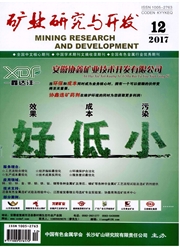

 中文摘要:
中文摘要:
为克服普通混凝土砌块墙作为巷旁支护时存在的弊端,借鉴建筑中常用的榫卯结构连接形式,设计了榫卯结构砌块墙。墙体由侧壁、中间凸块、侧壁组成,其长度比为1∶2∶1,凹口长度为砌块宽度加15mm,凹口高度为砌块高度二分之一,砌块内部焊接"Ш"型钢筋框架。利用该砌块墙在东滩煤矿3203工作面进行了工业试验,矿压观测结果表明,工作面后方24m处,矿压显现最剧烈,后方80m处,矿压显现趋于稳定;巷道底鼓量和墙体内移量远大于顶板下沉量和煤帮变形量;留巷复用期间矿压显现程度远低于上工作面回采期间;墙体结构形式、参数合理,留巷效果较好。
 英文摘要:
英文摘要:
To overcome the disadvantages of general concrete block as the drift side wall supporting,mortise and tenon joint structure block wall was designed by learning similar structure.The wall was built up of concrete blocks and middle projection blocks,with length ratio of block,projection block and side block 1∶2∶1.The length of projection was15 mm more than block width,and the height of project block is half of the general concrete block height and the steel frame of "Ш" shape was welded inside blocks.Industrial tests were done at No.3203 stope face of Dongtan Coal Mine by using this mortise and tenon block wall.Observation results on drift pressure showed that the highest pressure location was 24 mfrom the stope face and the stable pressure location was 80 m.The drift's bottom squeeze and wall displacement were far more serious than roof subsidence and coal-wall deformation.After mining,the drift pressure was much lower than before.The reasonable wall structure and parameter brought drift stable effect.
 同期刊论文项目
同期刊论文项目
 同项目期刊论文
同项目期刊论文
 期刊信息
期刊信息
